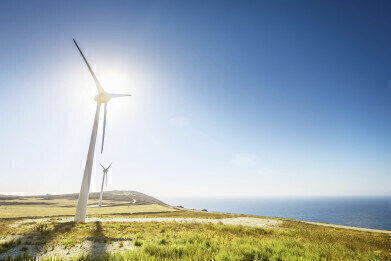Green energy
Potential $200 Billion Market to Convert Simple Cycle Gas Turbines to Combined Cycle Operation
Aug 05 2014
There is the potential to upgrade existing gas turbine plants by converting them to combined cycle operation. The cost will be $200 billion and will add 160,000 MW of additional capacity while reducing CO2 and other pollutants per unit of power produced. This is the conclusion reached by the McIlvaine Company (USA) in Gas Turbine and Combined Cycle Supplier Program. (www.mcilvainecompany.com)
The United States has been upgrading existing power plants and reducing emissions per unit of energy produced. CO2 emissions from U.S. power plants in 2013 were 20 percent lower than 1997 levels, thanks to the shift to CCGT technology. Reductions in NOx and SO2 emissions were even greater, dropping 40 percent and 44 percent, respectively. This is due to the installation of additional emission control equipment.
The GRF Tracy San Joaquin County conversion from 169 to 314 MW cost approximately $232 million or 1372/kW based on the simple cycle rate. From a different perspective, 145 additional MW will be generated at a cost of $1600/kW. The average cost, worldwide, is forecast by McIlvaine at $1000/kW of single cycle operation. There are presently 1.1 million MW of installed gas turbine capacity in the world. There is the potential to add combined cycle operation to 200,000 MW at an investment of $200 billion.
Individual upgrade projects are tracked in the program. Here are some examples:
The Rolling Hills Generating Facility in Vinton County, Ohio is proposing to convert from a simple cycle. The current facility utilises five natural gas-fired combustion turbines. The conversion would require expansion and redevelopment of the current generating facility, adding four heat recovery steam generators and two steam generators to four of the combustion turbines. One combustion turbine would remain as a simple cycle unit. The capacity will expand from 860 MW to 1,414 MW. The proposed conversion is estimated to cost $865 million ($1000/kW). Conversion of the plant would use all five of the existing Siemens 501FD2 natural gas-fired combustion turbine generators. The combustion turbine remaining in simple cycle configuration would have a nominal output of 172 MW. Four of the five combustion turbines would be coupled to Heat Recovery Steam Generators (HRSGs) and each would be equipped with 550 million British thermal units per hour (MMBtu/hour) duct burners. Each pair of gas combustion turbines would be combined with HRSGs and a steam turbine generator set to create 2 x 1 power blocks, each with a nominal output of approximately 621 MW. This company is affiliated with Tenaska Capital Management LLC.
Tampa Electric Polk station is converting four units to combined cycle operation and will increase generating capacity to 1400 MW. SCR will also be installed on all units. The project started earlier this year and will be completed in 2017.
The Empire District Electric Company (Empire District) owns and operates the Riverton Power Station) located in Riverton, Kansas. It currently consists of two boilers and four simple cycle combustion turbines. The combined cycle unit will have a nominal capacity of 250 MW. This will require the addition of a heat recovery steam generator (HRSG) with supplemental natural gas duct firing (duct burners) and a condensing steam turbine generator. The project also includes a cooling tower and an emergency diesel generator. An SCR will control NOx and a CO catalyst will control carbon monoxide (CO) and volatile organic compound (VOC).
Siemens has been awarded the contracts for the combined cycle conversion of two simple cycle power plants in Argentina by Unión Temporal de Empresas (UTE) a joint venture between Isolux Ingeniería and Inversora Andina Ibérica. The simple cycle plants, Ensenada de Barragán and Brigadier López, were originally designed and supplied by Siemens and are owned by Argentina's national energy company, ENARSA. Siemens will supply the power island equipment to close the combined cycles for these two plants, which will result in an additional 140 MW of power for Brigadier López and 280 MW additional for Ensenada de Barragán with no additional fuel consumption. The power plants are scheduled to achieve commercial operation in the fall of 2014.
AES Dominicana has selected Tecnicas Reunidas of Spain to lead the project to convert Dominican Power Partners' (DPP) power generating asset to combined-cycle. The conversion project will raise the current plant output from 210 MW to 324 MW.
In Saudi Arabia the 1300 MW Riyadh City simple cycle plant is being converted to combined cycle operation. Some units are already installed and the rest will be operating by middle 2015. The upgrades include: Forty (40) nos. Vertical/Horizontal Single/Dual Pressure Heat Recovery Steam Generating (HRSG) units with natural circulation, Ten (10) nos. Steam Turbine & Generator, Ten (10) Air Cooled Condenser, Boiler feed pump system and its associated auxiliaries, Continuous Emissions Monitoring System (CEMS) to monitor stacks emissions.
Kawasaki has converted a number of plants from simple to combined cycle. These include:
- Malaysia/Gelugor - GE Frame 9E x 2 converted to Combined Cycle
- Myanmar /Ahlone - GEC-Alsthom Frame 6 x 3 converted to Combined Cycle
- Myanmar/Hlawga - GEC-Alsthom Frame 6 x 3 converted to Combined Cycle
- Myanmar/Tharkayta- Hitachi Frame 5 x 3 converted to Combined Cycle
Black & Veatch has executed the design and construction of several combined cycle conversions including a conversion to a 2 x 1 configuration in California involving "F" class turbines and a conversion to a 3 x 1 configuration in Malaysia involving "E" class turbines.
Events
May 18 2025 Algiers, Algeria
23rd International Water Management Exhibition
May 20 2025 Prague, Czech Republic
Singapore International Water Week Spotlight 2025
Jun 23 2025 Singapore
Jun 25 2025 Sao Paulo, Brasil
Jul 02 2025 Bangkok, Thailand














